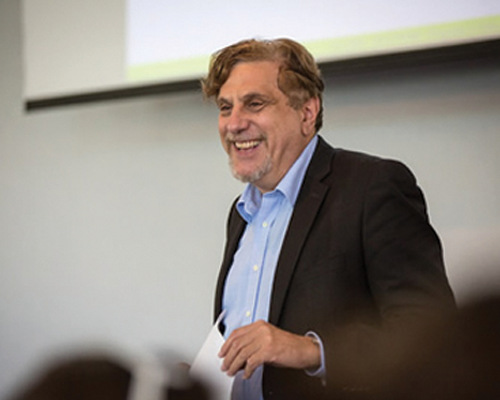What are the accomplishments you are most proud of?
My team and I created a "translational center," PEAR at Harvard and McLean, that moves back and forth between after school practice policy and research. I always had the dream that universities would make significant contributions to our communities and to create scholarship that is directly benefiting children and youth. I believe that we have made great strides in that direction.
Where do you see the field in ten years?
I see thriving program ecology with serious and fun learning opportunities that contribute to the overall resiliency and success of young peoples' lives. Quality will have improved and will be more consistent across the sector. And the influence of youth development thinking will have entered more of the mainstream of education, bringing
afterschool practices to schools, families, and children, all day and all year.
What are the biggest opportunities for the afterschool industry?
First, I believe right now that the cutting edge for afterschool is to demonstrate in the area of STEM how exploration, inquiry, and engagement can make students better learners. Second, I believe the focus on socio-emotional development, natural to most afterschool settings, will increase health and success in children and youth. These two organizing principles, delivered through the mediums of arts, sports, and civic activities, are bringing children and adults closer together and will convince everyone that the afterschool hours are essential, require funding, and need to be high-quality.
What are the biggest challenges facing afterschool?
Fragmentation, funding, training, and status.
What makes an afterschool program successful?
A place where adults and children encounter each other, have fun together, and where deep learning occurs in a safe and nonjudgmental setting.
Edited by Amy L Charles, editorial director of AfterSchool Today magazine, the Official Publication of the National AfterSchool Association.
ABOUT GIL NOAM
Gil G. Noam, Ed.D., Ph.D. (Habil.)
Associate Professor, Harvard Medical School
Director, Program in Education, Afterschool and Resiliency (PEAR)
Belmont, Massachusetts
Professional Preparation
Freie Universitaet, Berlin Psychology B.A. 1972
Freie Universitaet, Berlin Clinical Psychology Dipl. Psych 1975
Harvard University Psychology Ed.D. 1984
University of Fribourg, Switzerland Clinical Psychology Habilitation 1993
Academic/Professional Appointments
2008- Present Visiting Professor, Norwegian Institute of Public Health, Oslo, Norway
1999-2000 Center for Advanced Study in Behavioral Sciences
1999- Present Founder and Director, Program in Education, Afterschool and Resiliency (PEAR), Harvard University
1996- Present Director, Assessment and Evaluative Services, Joint McLean - Fransiscan Child and Adolescent Programs
1996- Present Consultant in Psychology (Psychiatry)
1995-1996 Director, Risk and Prevention Program, Harvard Graduate School of Education
1994- Present Psychologist and Child Psychologist, McLean Hospital
1994- Present Director, Harvard/McLean RALLY Prevention Program
1994- Present Visiting Professor, University of Fribourg, Switzerland
1993- Present Associate Professor of Psychology (Psychiatry), Harvard Medical School
1993-2004 Associate Professor in Education, Department of Human Development and Psychology, Harvard University
1988- Present Director, Hall-Mercer Laboratory of Developmental Psychology and Developmental Psychopathology
Publications
Selected relevant publications:
1. Noam, G. G., & Miller, B. (2002). Youth Development and After-School Time: A Tale of Many Cities. New Directions for Youth Development, 94 (3).
2. Noam, G. G., Biancarosa, G., & Dechausay, N. (2002). Afterschool Education: Approaches to an Emerging Field. Cambridge, MA: Harvard Education Press.
3. Noam, G. G. (2004). Afterschool Worlds: Creating a new social space for development and learning. New Directions for Youth Development, 101 (2).
4. Noam, G. G., & Wahl-Moehlman, L. (2005). The four C's of afterschool: A new case study method for a new field. In: Paper Series of the Baun Foundation. New York: 2005.
5. Malti, T., Liu, C. H. J., & Noam, G. G. (2010). Holistic assessment in school-based, developmental prevention. Journal of Prevention and Intervention in the Community, 38, 244-259.
Other significant publications:
1. Noam, G. G. (1996). High-risk children: Transforming our understanding of human development. Human Development, 29, 1-17.
2. Noam, G. G., & Fischer, K. (1996). Development and vulnerability in closer relationships. New Jersey: Erlbaum.
3. Noam, G. G.(1998). Clinical-developmental psychology: Towards developmentally differentiated interventions. In I. Sigel & A. Renninger (Ed.), Handbook of child psychology: Vol. 4. Child psychology in practice (pp. 585 - 634). New York: Wiley.
4. Noam, G. G. (1999). The psychology of belonging: Reformulating adolescent development. In L. Flaherty & H. Horowitz (Ed.), Adolescent psychiatry, development and clinical studies, Volume 24 (pp. 49 - 68). Hillside, New Jersey: Annals of the American Society for Adolescent Psychiatry.
5. Noam, G. G., & Hermann, C. (2002). Where education and mental health meet: Developmental prevention and early intervention in schools. Developmental and Psychopathology, 14, 861-875.
Current Synergistic Activities
• Documenting the nature of student participation and learning in science activities in "typical" (non-science-specific) afterschool programs, and the infrastructure required to support these programs through an NSF-funded ILSA project (2008-2010).
• Development of PEAR Impact training curriculum, training prototypes and the piloting of the program in two school districts and one youth-serving organization through the "Train the Trainer" program funded by the Alden Trust (2009-2011).
• Increased the number of users and visits to the ATIS website, added ratings and reviews for each tool, and added new tools to the site through the "Marketing and Improving the Assessment Tools in Informal Science Website" project funded by the Noyce Foundation.
Collaborators & Other Affiliations
- Feldhaus, Charlie (IUPUI); Marrs, Kathy (IUPUI); Covault, Jacquelyn (Purdue); Knox, Dré (Indiana Department of Education); Sorge, Brandon (IUPUI-SERI); Shaw, Ashima (Harvard); Kirkley, Sonny (WisdomTools)
- Thesis Advisor and Postgraduate-Scholar Sponsor
- Ph.D. Advisor to Carolyn Treasure and Azucena Ramos
- Postgraduate-Scholar Sponsor to Dr. Ashima Shaw

